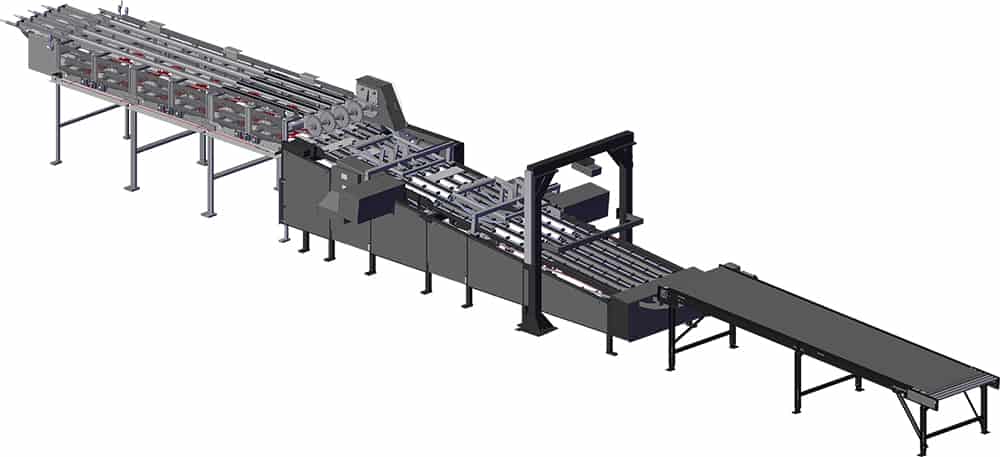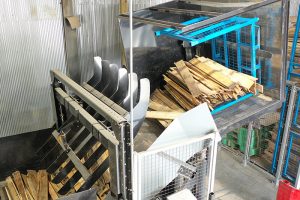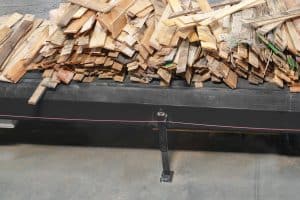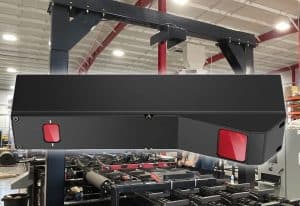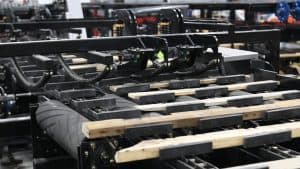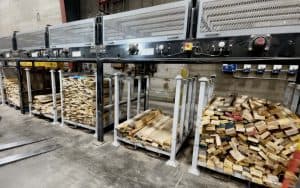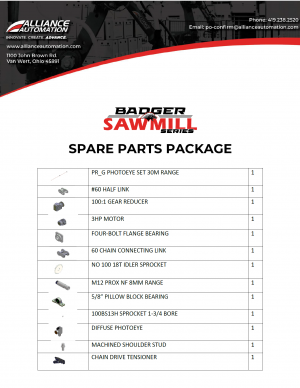
SCAN. OPTIMIZE. TRIM. SORT.
Board Dimensions Trimming & Sorting
• Width 1.5” to 6”
• Thickness 3/8” to 2”
• Length 28” to 52”
– 20” length cut available
Stringer Dimensions
• Width (Height) 1” to 4”
• Length 28” min to 52” max
• Thickness 1” to 2”
Sorting Capabilities
• Drop style sorter
• Sorting category
– Minimum of 4 sort categories
– Maximum of 12 sort categories
– Sortation of boards and stringers (2-way or 4-way)
in the same run
• End of line reject location
• Quantity counts (Total of job, bin total, shift total)
Vision System
• Precision 3D laser image data acquisition
• Configurable tolerances and detection is standard
– Corner missing
– Middle missing
Optimization Software
• Integrated computer and PLC data acquisition
• Computer based optimizing software with
bi-lingual full interface
• Pre-set dimension management/recipe
prioritization management (length/width/
thickness combination)
• Bin selection with max count function
Features
• (2) 10 hp saws
• Dust collection ports provided
• Variable speed
• Operator foot-pedal controller infeed conveyor
• Production and inventory reporting
• 4” fence travel per side (8” total)
– 10” optional travel per side (20” total)
Customization based on your needs.
Increase the feed speed with The Robotic Pallet Dismantler
Combine with our Sort & Repair Systems
Badger Sawmill Series
The increased adoption of the Robotic Pallet Dismantler, by all sizes of facilities in the pallet industry, has given rise to the Badger Sawmill Series. The Badger Sawmill Series will scan every piece of lumber through our vision system to determine length, width and thickness to trim the lumber to the preset dimensions. This process will maximize every piece of lumber. You get the key functions of scanning, optimizing, trimming, and sorting in a smaller footprint that will increase your yield gain by 10%.

DYNAMIC DUO Robotic Pallet Dismantler feeding the Badger Sawmill Series
When working together, this dynamic duo will increase efficiency, yield, throughput and safety.
Empower your growth with EQUIPMENT FINANCING!
Structured financing allows you to get maximum benefit from your investment with minimal bottom line impact, all while building equity towards equipment ownership. We have partnerships with long-tenured lease and finance managers who understand the industry to help you to explore all of your options. Learn more about our financing options.
BADGER SAWMILL SERIES PRODUCT BROCHURE
Take a closer look at the benefits your company will gain with the Badger Sawmill Series. Follow the link to download the brochure for specifications.
B.Y.O.B.
BUILD YOUR OWN BADGER
The Badger Sawmill Series comes standard
with the following capabilities:
- 20’ inclined, 48” wide infeed belt conveyor with lumber presentation device
- Line speed of 15,000 board per 7.5 hour shift
- Single cut saw deck capable of cutting boards
- Width: 1.5″ to 6″
- Thickness: 3/8″ to 2″
- Length: 28″ to 52″
- Fence travel 4″ per side with a total of 8″ trim.
- 10’ Long 36” wide outfeed conveyor
- 57’ 2¾”

Build Your Own Badger By Filling Out This Form
The Badger Sawmill Series comes with standardization but here you can customize your Badger to fit the needs of your business.
BADGER SAWMILL SERIES
SPARE PARTS PACKAGE
Are you in need of additional parts for your Badger Sawmill Series? Take a look at the spare parts package we have to offer by downloading the file below.
Badger Sawmill Series FAQ
- Scanning technology uses the same 3D line scan hardware and software.
- The PLC (programmable logic controllers) and HMI (human-machine interface) programming are adapted from the Urban Sawmill.
- The Infeed conveyor is the same heavy-duty construction.
- Saw motors, saw blades, fence servo actuators, duck bills, and duck bill cylinders are all the same.
- Speed and the maximum boards cut per shift is reduced.
- Maximum board length drops 10” from 62” down to 52”.
- Maximum board width is 2” less, from 8” down to 6”.
- No drop deck or unscrambler on standard sawmill, these are options.
- Lumber presentation device has been added to the end of the infeed conveyor on the Badger Sawmill.
- Lumber infeed will be controlled by a foot pedal rather than automatically via sensors.
- The operator loads directly to the saw deck, thus removal of the staging and lug loader sections.
- The saw deck chain and drop sorter chain changed from 81X chain to 2080 chain.
- The saw deck is angled to remove the need for an operator platform.
- Duck bill cylinder has been improved to a fixed welded arm rather than the QD bushing.
- Redesigned drop sorter frame to remove unnecessary material (no functional or durability loss).
- The Badger is identified as a series because of the different speeds available and the optional 20” board cut option. A 150 series sawmill will provide you 15,000 boards per shift, a 200 series will provide you with 20,000 boards per shift. If you opt to add the “S” series to your 150 or 200 you will be able to cut 20” boards.
- Lumber fed to the machine on a consistent basis. (Never starved)
- Lug fill percentage of 90%+ will allow you to process more boards.
- The lumber loader should not be sorting out blocks, broken boards, or other debris.
- Running speed of the machine directly impacts the operation and maximizing output.
- Attention to the machine, clearing jams, skews, and vision failures quickly.
- Operation hours of the machine are also critical to output success and maximization.
Failures in any of these keys will lead to reduced productivity. All the keys are very achievable, but they must be prioritized to achieve maximum production.
- The Badger Sawmill does not require any more maintenance than any other wood equipment. Greasing bearings and chains on a schedule, cleaning sensors and camera lenses, checking bolt tightness, and general cleaning is all that is required. We provide a full maintenance schedule within the manual.
OPTIONS
- The Control interface to the machine is programmed in both Spanish and English. You just hit a button to toggle between the two languages.
- The saw deck load operator can work from either side. It is often a best practice for the bin tender and the lug loader to be on the same side so they can communicate, though this is not required.
- Alliance Automation does not offer dust collection systems. We do provide dust collection ports in the saw covers. It is the end user’s responsibility and liability to add dust collection if they desire.
- It allows for the trimmed material to be brought to one side of the machine. This is often helpful if the machine is against a wall. Since the conveyors are an inclined rough top belt, it allows for a larger trim hopper to be used thereby lengthening the service interval.
BLADES
The blade life can vary greatly with blades from different manufacturers and condition, but the average expected blade life is 40,000 to 50,000 cuts for a new blade. Sharpened blades seem to last a bit less than new with about 30,000 to 40,000 cuts. The number of cuts is kept in the saw control pop-ups, which need to be reset manually when a blade is changed out.
Typical blade life between resharpening is 2 shifts if running deck boards only. 1 shift if running stringers only.
- We recommend a total of 10 blades, therefore the system comes with 10 blades at the time of purchase. If you are only running deck boards, one shift a day, and you have a weekly re-sharp rotation = 5 blades a week in the plant, 5 blades being re-sharpened, and we recommend an additional 5
- Very easy to change. One bolt to access the guard, one nut holding the blade on. An average technician should be able to change both blades in under 5 minutes.
CUTTING
- This option changes the design of the entire system. The saw deck will require two additional justification rollers, and an additional chain strand. The drop sort would also requires an additional chain to be added. This feature will also require additional sensing throughout the machine.
- There are no disadvantage. It simply allows more flexibility in cutting options. It allows you to cut a 52” board down to 32”. The big advantage for most customers is cutting a 52” down to 40”. The standard 8” cut will not allow for this.
- Yes, it would make the system more affordable, but you lose the opportunity to cut boards and strings at the same time.
REJECTS
- “failed to fence” there is a sensor to tell the machine if the board to be cut registered on the moving fence. If the board does not make it, this is a “fail to fence”. Reasons for fail to fence: nails sticking down, and extreme bowing are the main reasons
- “destination not found” This is when the machine simply cannot cut the board to any of the categories set up in the drop sort bins.
- This greatly varies based on the quality of the inbound product. In general, we expect to see less than 5% rejects
- Any boards that were rejected for “fail to fence” have a chance to get cut and sorted during the second pass. “destination not found” boards will be rejected again.
- The three scenarios that will stop the Badger Sawmill are “vision system immediate reject”, which is an incoming board that is either too long or too short, more than one board in a lug, or a “skewed” board, this is when a board will be kicked at the saw and become “skewed” in the chain lugs. All three of the above scenarios take a few seconds to recover from.
- The percentage that you set for corner and middle missing is the allowable percentage of the width, or middle of a board you don’t mind missing on good boards. Default setting of 90 means 90 percent of the corner or middle can be missing on a good board (3.5” wide board could have 3.15” missing and still be good). If the board is being cut down to fit a board spec., the final cut board is where the percent missing will be checked (a missing corner could be cut down to remove the part that had too much missing). The vision system needs about an inch of board on the ends of width, to measure the length accurately but makes the missing determination on the final ends of the board.
Crack sensitivity allows for adjusting how large of a crack in the board the system should allow. Most customers set the sensitivity to 100% and let the pallet assembly person determine if the board is acceptable, but setting for more sensitive (near 0) will reject boards with visible cracks.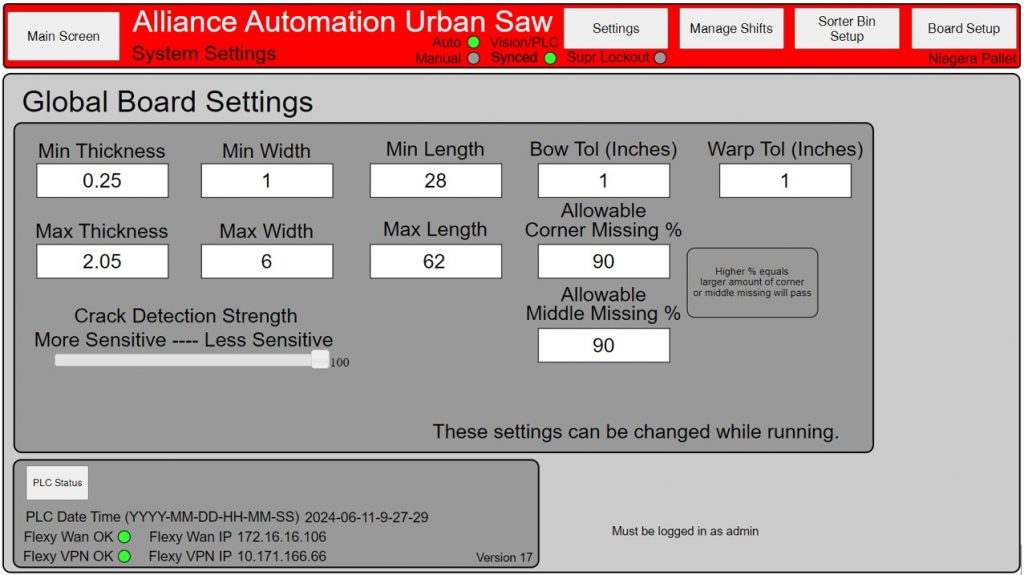
The recipes were added to the USL to allow for storage and retrieval of board types and their associated bins and priorities. When the USL is setup for a certain customer or variety of lumber that will be sorted, this configuration can be saved in one of 10 different memory locations. When this configuration needs to be run again, it can be loaded from the memory thus saving some time setting up the machine for frequently used setups. The recipe stores the boards configured for each bin and the associated priorities. It does not save board specifications. Any time a board specification is changed, the new values will be loaded with the recipes.
With Supervisor Machine Lockout enabled, select a recipe number between 1 and 10 and press save to copy boards and current priorities into that memory location. Later, after running a different setup, the previous saved configurations can be loaded by entering the number that they were saved as and pressing load. It may be a good idea to create a record of what is saved in each location to prevent overwriting recipes.

INFEED OPTIONS
- Infeed belt, drop deck, and unscrambler are all designed with productivity in mind. This infeed combination gives you the most flexibility of how you present lumber to the machine, and provides the lug loader with the most consistent board flow
- Lug loader pulling right out of a bin is the most cost-effective infeed option. You will give up throughput and it is a less than ideal ergonomic design. The stand-alone infeed belt conveyor is a great, cost-effective method to feed the machine.
- You do not need a drop deck with an unscrambler, without a drop deck, you will need to be more diligent about making sure the product on the infeed belt is free of blocks, broken boards, etc. The main function of the drop deck is to allow “trash” to fall through and prevent unscrambler jamming due to trash.
- The ability to load a full bin of lumber and drive away. The tipping and metering out is controlled by the lug loader.
BINS
- This depends on the speed you are running, the lug fill percentage, and what percentage of boards are going into a specific bin. On average, 3/8” thick – 4” wide boards: full-size average: 700 boards; compact average: 350 boards
- You can put a full-size bin under two compact drop categories. You would just need to assign both categories to the same board.
- You can load and unload bins from either side of the machine. Note: all the boards in the drop sort area are justified to the left side of the machine (left side as you are traveling down the machine as a board would) Keep this is mind, as it is easier to straighten boards out in a bin on the left side of the sort deck.
- The bin system is modular in design. Each module has two sort categories for both the Standard and Compact drop sorters.
The bin setup can be accomplished at the machine or from a remote computer.
INSTALLATION
- Installation takes roughly two weeks. One week to setup the Badger in your facility with your chosen options. The second week is operating the machine and training. The expectation is by noon of the second week you are running full production with assistance from the Alliance training professional. There are a handful of items the customer must be ready with and accomplish in a timely manner for a smooth installation.
BENEFITS
- Increase throughput of cut lumber
- Process boards and stringers at the same time
- Ensure lumber is cut to maximize every piece
- Eliminate the need for multiple manual saws
- Ensure a safer work environment
ALLIANCE SUPPORT
- Concept designed to fit your facility
- Install and training included
- Post install support
- Daily production report available
- Remote service access
- One year warranty
- Assigned service team
ADDITIONAL OPTIONS
- Multiple infeed options
- Bulk vs. hand unload
- Custom configuration of sort categories
- Peripheral equipment integration
- Sawdust/scrap conveyance
- Multi-year service plan
You Can't Afford Not to Adopt Automation
Think automation is too expensive for your business? Think again.
With the help of our current automation users, we have developed a payback calculator to show how affordable adopting automation is. Click the link below and enter in your company’s data to see just how cost-effective automation can be for you.
